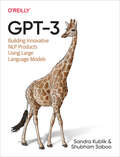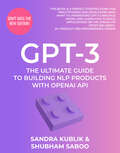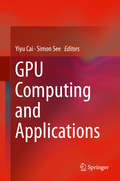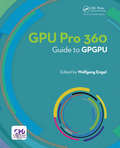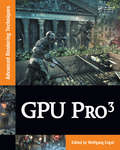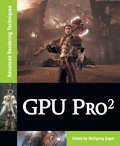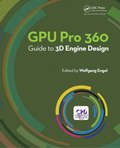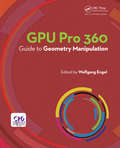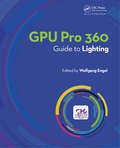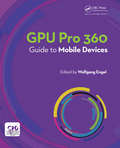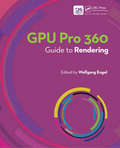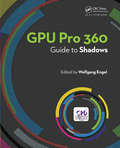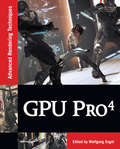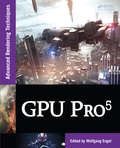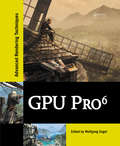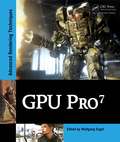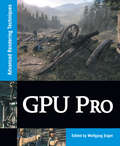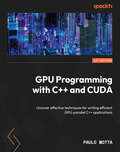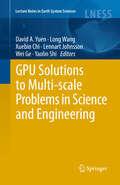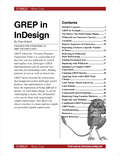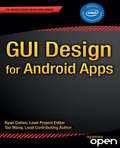- Table View
- List View
GPT for Python-Coding in Computational Materials Science and Mechanics: From Prompt Engineering to Solutions in Worked-Out Examples (Studies in Computational Intelligence #1198)
by Bernhard EidelThis book covers all the topics about ChatGPT required to successfully generate Python code to solve problems in computational materials science and mechanics, complemented by numerous fully worked-out applications. The complete work flow for AI-assisted coding is given, including: (i) prompt engineering providing a powerful toolset for how to give coding assignments to ChatGPT effectively; (ii) commented code listings; and (iii) tips and tricks to verify the codes in rigorous tests including human interventions to fix issues and gaps. Finally, (iv) the coding projects are critically reviewed to address the strengths and remaining weaknesses of the Chatbot, including explicit recommendations on how to communicate with GPT. For the steps (i)–(iv) the book presents a curated selection of intriguing problems from computational materials science and computational mechanics including machine learning for problem-solving. These problems are carefully chosen for their relevance to current research and industrial applications and their suitability for showcasing the advanced capabilities of GPT-4 for code generation. Spanning from predicting material behavior under various conditions to simulating complex mechanical interactions, the problems serve as a canvas on which GPT-4 paints its solutions, demonstrating not just accuracy but creativity in problem-solving. Therefore, the book serves as a valuable primer for both undergraduate and graduate students, as well as a review for research scientists and practicing engineers.
GPT-3
by Sandra Kublik Shubham SabooGPT-3: NLP with LLMs is a unique, pragmatic take on Generative Pre-trained Transformer 3, the famous AI language model launched by OpenAI in 2020. This model is capable of tackling a wide array of tasks, like conversation, text completion, and even coding with stunningly good performance. Since its launch, the API has powered a staggering number of applications that have now grown into full-fledged startups generating business value. This book will be a deep dive into what GPT-3 is, why it is important, what it can do, what has already been done with it, how to get access to it, and how one can build a GPT-3 powered product from scratch.This book is for anyone who wants to understand the scope and nature of GPT-3. The book will evaluate the GPT-3 API from multiple perspectives and discuss the various components of the new, burgeoning economy enabled by GPT-3. This book will look at the influence of GPT-3 on important AI trends like creator economy, no-code, and Artificial General Intelligence and will equip the readers to structure their imaginative ideas and convert them from mere concepts to reality.
GPT-3: The Ultimate Guide To Building NLP Products With OpenAI API
by Sandra Kublik Shubham SabooGPT-3: The Ultimate Guide To Building NLP Products With OpenAI API is a comprehensive book on the Generative Pre-trained Transformer 3 AI language model, covering its significance, capabilities, and application in creating innovative NLP Products.Key FeaturesExploration of GPT-3: The book explores GPT-3, a powerful language model, and its capabilitiesBusiness applications: The book provides practical knowledge on using GPT-3 to create new business productsExamination of AI trends: The book examines the impact of GPT-3 on emerging creator economy and trends like no-code & AGIBook DescriptionGPT-3 has made creating AI apps simpler than ever. This book provides a comprehensive guide on how to utilize the OpenAI API with ease. It explores imaginative methods of utilizing this tool for your specific needs and showcases successful businesses that have been established through its use.The book is divided into two sections, with the first focusing on the fundamentals of the OpenAI API. The second part examines the dynamic and thriving environment that has arisen around GPT-3.Chapter 1 sets the stage with background information and defining key terms. Chapter 2 goes in-depth into the API, breaking it down into its essential components, explaining their functions and offering best practices. Chapter 3, you will build your first app with GPT-3.Chapter 4 features interviews with the founders of successful GPT-3-based products, who share challenges and insights gained. Chapter 5 examines the perspective of enterprises on GPT-3 and its potential for adoption. The problematic consequences of widespread GPT-3 adoption, such as misapplication and bias, are addressed along with efforts to resolve these issues in Chapter 6. Finally, Chapter 7 delves into the future by exploring the most exciting trends and possibilities as GPT-3 becomes increasingly integrated into the commercial ecosystem.What you will learnLearn the essential components of the OpenAI API along with the best practicesBuild and deploy your first GPT-3 powered applicationLearn from the journeys of industry leaders, startup founders who have built and deployed GPT-3 based products at scaleLook at how enterprises view GPT-3 and its potential for adoption for scalable solutionsNavigating the Consequences of GPT-3 adoption and efforts to resolve themExplore the exciting trends and possibilities of combining models with GPT-3 with No codeWho this book is forThis book caters to individuals from diverse backgrounds, not just technical experts. It should be useful to you if you are:A data expert seeking to improve your AI expertiseAn entrepreneur looking to revolutionize the AI industryA business leader seeking to enhance your AI knowledge and apply it to informed decision makingA content creator in the language domain looking to utilize GPT-3's language abilities for creative and imaginative projectsAnyone with an AI idea that was previously deemed technically unfeasible or too costly to execute
GPU Computing and Applications
by Yiyu Cai Simon SeeThis book presents a collection of state of the art research on GPU Computing and Application. The major part of this book is selected from the work presented at the 2013 Symposium on GPU Computing and Applications held in Nanyang Technological University, Singapore (Oct 9, 2013). Three major domains of GPU application are covered in the book including (1) Engineering design and simulation; (2) Biomedical Sciences; and (3) Interactive & Digital Media. The book also addresses the fundamental issues in GPU computing with a focus on big data processing. Researchers and developers in GPU Computing and Applications will benefit from this book. Training professionals and educators can also benefit from this book to learn the possible application of GPU technology in various areas.
GPU PRO 360 Guide to GPGPU
by Wolfgang EngelWolfgang Engel’s GPU Pro 360 Guide to GPGPU gathers all the cutting-edge information from his previous seven GPU Pro volumes into a convenient single source anthology that covers general purpose GPU. This volume is complete with 19 articles by leading programmers that focus on the techniques that go beyond the normal pixel and triangle scope of GPUs and take advantage of the parallelism of modern graphics processors to accomplish such tasks. GPU Pro 360 Guide to GPGPU is comprised of ready-to-use ideas and efficient procedures that can help solve many computer graphics programming challenges that may arise. <P><P>Key Features: <li>Presents tips & tricks on real-time rendering of special effects and visualization data on common consumer software platforms such as PCs, video consoles, mobile devices <li>Covers specific challenges involved in creating games on various platforms <li>Explores the latest developments in rapidly evolving field of real-time rendering <li>Takes practical approach that helps graphics programmers solve their daily challenges
GPU PRO 3: Advanced Rendering Techniques
by Wolfgang EngelGPU Pro3, the third volume in the GPU Pro book series, offers practical tips and techniques for creating real-time graphics that are useful to beginners and seasoned game and graphics programmers alike.Section editors Wolfgang Engel, Christopher Oat, Carsten Dachsbacher, Wessam Bahnassi, and Sebastien St-Laurent have once again brought together a h
GPU Parallel Program Development Using CUDA (Chapman & Hall/CRC Computational Science)
by Tolga SoyataGPU Parallel Program Development using CUDA teaches GPU programming by showing the differences among different families of GPUs. This approach prepares the reader for the next generation and future generations of GPUs. The book emphasizes concepts that will remain relevant for a long time, rather than concepts that are platform-specific. At the same time, the book also provides platform-dependent explanations that are as valuable as generalized GPU concepts. The book consists of three separate parts; it starts by explaining parallelism using CPU multi-threading in Part I. A few simple programs are used to demonstrate the concept of dividing a large task into multiple parallel sub-tasks and mapping them to CPU threads. Multiple ways of parallelizing the same task are analyzed and their pros/cons are studied in terms of both core and memory operation. Part II of the book introduces GPU massive parallelism. The same programs are parallelized on multiple Nvidia GPU platforms and the same performance analysis is repeated. Because the core and memory structures of CPUs and GPUs are different, the results differ in interesting ways. The end goal is to make programmers aware of all the good ideas, as well as the bad ideas, so readers can apply the good ideas and avoid the bad ideas in their own programs. Part III of the book provides pointer for readers who want to expand their horizons. It provides a brief introduction to popular CUDA libraries (such as cuBLAS, cuFFT, NPP, and Thrust),the OpenCL programming language, an overview of GPU programming using other programming languages and API libraries (such as Python, OpenCV, OpenGL, and Apple’s Swift and Metal,) and the deep learning library cuDNN.
GPU Pro 2
by Wolfgang EngelThis book focuses on advanced rendering techniques that run on the DirectX and/or OpenGL run-time with any shader language available. It includes articles on the latest and greatest techniques in real-time rendering, including MLAA, adaptive volumetric shadow maps, light propagation volumes, wrinkle animations, and much more. The book emphasizes te
GPU Pro 360 Guide to 3D Engine Design
by Wolfgang EngelWolfgang Engel’s GPU Pro 360 Guide to 3D Engine Design gathers all the cutting-edge information from his previous seven GPU Pro volumes into a convenient single source anthology that covers the design of a 3D engine. This volume is complete with articles by leading programmers that focus on various aspects of 3D engine design such as quality and optimization as well as high-level architecture. GPU Pro 360 Guide to 3D Engine Design is comprised of ready-to-use ideas and efficient procedures that can help solve many computer graphics programming challenges that may arise. <P><P>Key Features: <li>Presents tips & tricks on real-time rendering of special effects and visualization data on common consumer software platforms such as PCs, video consoles, mobile devices <li>Covers specific challenges involved in creating games on various platforms <li>Explores the latest developments in rapidly evolving field of real-time rendering <li>Takes practical approach that helps graphics programmers solve their daily challenges
GPU Pro 360 Guide to Geometry Manipulation
by Wolfgang EngelWolfgang Engel’s GPU Pro 360 Guide to Geometry Manipulation gathers all the cutting-edge information from his previous seven GPU Pro volumes into a convenient single source anthology that covers geometry manipulation in computer graphics. This volume is complete with 19 articles by leading programmers that focus on the ability of graphics processing units to process and generate geometry in exciting ways. GPU Pro 360 Guide to Geometry Manipulation is comprised of ready-to-use ideas and efficient procedures that can help solve many computer graphics programming challenges that may arise. <P><P> Key Features: <li> Presents tips and tricks on real-time rendering of special effects and visualization data on common consumer software platforms such as PCs, video consoles, mobile devices <li> Covers specific challenges involved in creating games on various platforms <li> Explores the latest developments in the rapidly evolving field of real-time rendering <li> Takes a practical approach that helps graphics programmers solve their daily challenges
GPU Pro 360 Guide to Image Space
by Wolfgang EngelWolfgang Engel’s GPU Pro 360 Guide to Image Space gathers all the cutting-edge information from his previous seven GPU Pro volumes into a convenient single source anthology that covers various algorithms that operate primarily in image space. This volume is complete with 15 articles by leading programmers speaks to the power and convenience of working in screen space. GPU Pro 360 Guide to Image Space is comprised of ready-to-use ideas and efficient procedures that can help solve many computer graphics programming challenges that may arise. <P><P> Key Features: <li>Presents tips & tricks on real-time rendering of special effects and visualization data on common consumer software platforms such as PCs, video consoles, mobile devices <li>Covers specific challenges involved in creating games on various platforms <li>Explores the latest developments in rapidly evolving field of real-time rendering <li>Takes practical approach that helps graphics programmers solve their daily challenges
GPU Pro 360 Guide to Lighting
by Wolfgang EngelWolfgang Engel’s GPU Pro 360 Guide to Lighting gathers all the cutting-edge information from his previous seven GPU Pro volumes into a convenient single source anthology on lighting. This volume is complete with 24 articles by leading programmers that describes rendering techniques of global illumination effects suited for direct rendering applications in real time. GPU Pro 360 Guide to Lighting is comprised of ready-to-use ideas and efficient procedures that can help solve many computer graphics programming challenges that may arise. <P><P>Key Features: <li>Presents tips and tricks on real-time rendering of special effects and visualization data on common consumer software platforms such as PCs, video consoles, and mobile devices <li>Covers specific challenges involved in creating games on various platforms <li>Explores the latest developments in the rapidly evolving field of real-time rendering <li>Takes a practical approach that helps graphics programmers solve their daily challenges
GPU Pro 360 Guide to Mobile Devices
by Wolfgang EngelWolfgang Engel’s GPU Pro 360 Guide to Mobile Devices gathers all the cutting-edge information from his previous seven GPU Pro volumes into a convenient single source anthology that covers computer graphics in mobile devices. This volume is complete with 18 articles by leading programmers that focus on the ability of graphics processing units to process and generate geometry in exciting ways. GPU Pro 360 Guide to Mobile Devices is comprised of ready-to-use ideas and efficient procedures that can help solve many computer graphics programming challenges that may arise. <P><P>Key Features: <li>Presents tips & tricks on real-time rendering of special effects and visualization data on common consumer software platforms such as PCs, video consoles, mobile devices <li>Covers specific challenges involved in creating games on various platforms <li>Explores the latest developments in rapidly evolving field of real-time rendering <li>Takes practical approach that helps graphics programmers solve their daily challenges
GPU Pro 360 Guide to Rendering
by Wolfgang EngelWolfgang Engel’s GPU Pro 360 Guide to Rendering gathers all the cutting-edge information from his previous seven GPU Pro volumes into a convenient single source anthology that covers real-time rendering. This volume is complete with 32 articles by leading programmers that focus on the ability of graphics processing units to process and generate rendering in exciting ways. GPU Pro 360 Guide to Rendering is comprised of ready-to-use ideas and efficient procedures that can help solve many rendering programming challenges that may arise. Key Features: Presents tips and tricks on real-time rendering of special effects and visualization data on common consumer software platforms such as PCs, video consoles, and mobile devices Covers specific challenges involved in creating games on various platforms Explores the latest developments in the rapidly evolving field of real-time rendering Takes a practical approach that helps graphics programmers solve their daily challenges
GPU Pro 360 Guide to Shadows
by Wolfgang EngelWolfgang Engel’s GPU Pro 360 Guide to Shadows gathers all the cutting-edge information from his previous seven GPU Pro volumes into a convenient single source anthology that covers various algorithms that are used to generate shadow data. This volume is complete with 15 articles by leading programmers that focus on achieving good visual results in rendering shadows. GPU Pro 360 Guide to Shadows is comprised of ready-to-use ideas and efficient procedures that can help solve many computer graphics programming challenges that may arise. <P><P>Key Features: <li>Presents tips & tricks on real-time rendering of special effects and visualization data on common consumer software platforms such as PCs, video consoles, mobile devices <li>Covers specific challenges involved in creating games on various platforms <li>Explores the latest developments in rapidly evolving field of real-time rendering <li>Takes practical approach that helps graphics programmers solve their daily challenges
GPU Pro 4: Advanced Rendering Techniques
by Wolfgang EngelGPU Pro4: Advanced Rendering Techniques presents ready-to-use ideas and procedures that can help solve many of your day-to-day graphics programming challenges. Focusing on interactive media and games, the book covers up-to-date methods for producing real-time graphics.Section editors Wolfgang Engel, Christopher Oat, Carsten Dachsbacher, Michal Vali
GPU Pro 5: Advanced Rendering Techniques
by Wolfgang EngelIn GPU Pro5: Advanced Rendering Techniques, section editors Wolfgang Engel, Christopher Oat, Carsten Dachsbacher, Michal Valient, Wessam Bahnassi, and Marius Bjorge have once again assembled a high-quality collection of cutting-edge techniques for advanced graphics processing unit (GPU) programming. Divided into six sections, the book covers render
GPU Pro 6: Advanced Rendering Techniques
by Wolfgang EngelThe latest edition of this bestselling game development reference offers proven tips and techniques for the real-time rendering of special effects and visualization data that are useful for beginners and seasoned game and graphics programmers alike.Exploring recent developments in the rapidly evolving field of real-time rendering, GPU Pro6: Advance
GPU Pro 7: Advanced Rendering Techniques
by Wolfgang EngelThe latest edition of this bestselling game development reference offers proven tips and techniques for the real-time rendering of special effects and visualization data that are useful for beginners and seasoned game and graphics programmers alike.Exploring recent developments in the rapidly evolving field of real-time rendering, GPU Pro 7: Advanc
GPU Pro: Advanced Rendering Techniques
by Wolfgang EngelThis book covers essential tools and techniques for programming the graphics processing unit. Brought to you by Wolfgang Engel and the same team of editors who made the ShaderX series a success, this volume covers advanced rendering techniques, engine design, GPGPU techniques, related mathematical techniques, and game postmortems. A special emphasi
GPU Programming with C++ and CUDA: Uncover effective techniques for writing efficient GPU-parallel C++ applications
by Paulo MottaLearn to solve parallel problems with GPU-accelerated C++ code and create reusable libraries that can be accessed from other programming languagesKey FeaturesHarness the power of GPU parallelism to accelerate real-world tasksUtilize CUDA streams and scale performance with custom C++ solutionsCreate reusable GPU libraries and expose them to Python seamlesslyBook DescriptionWritten by Paulo Motta, a senior researcher with decades of experience, this comprehensive GPU programming book is an essential guide for leveraging the power of parallelism to accelerate your computations. The first section introduces the concept of parallelism and provides practical advice on how to think about and utilize it effectively. Starting with a basic GPU program, you then gain hands-on experience in managing the device. This foundational knowledge is then expanded by parallelizing the program to illustrate how GPUs enhance performance. The second section explores GPU architecture and implementation strategies for parallel algorithms, and offers practical insights into optimizing resource usage for efficient execution. In the final section, you will explore advanced topics such as utilizing CUDA streams. You will also learn how to package and distribute GPU-accelerated libraries for the Python ecosystem, extending the reach and impact of your work. Combining expert insight with real-world problem solving, this book is a valuable resource for developers and researchers aiming to harness the full potential of GPU computing. The blend of theoretical foundations, practical programming techniques, and advanced optimization strategies it offers is sure to help you succeed in the fast-evolving field of GPU programming.What you will learnManage GPU devices and accelerate your applicationsApply parallelism effectively using CUDA and C++Choose between existing libraries and custom GPU solutionsPackage GPU code into libraries for use with PythonExplore advanced topics such as CUDA streamsImplement optimization strategies for resource-efficient executionWho this book is forC++ developers and programmers interested in accelerating applications using GPU programming will benefit from this book. It is suitable for those with solid C++ experience who want to explore high-performance computing techniques. Familiarity with operating system fundamentals will help when dealing with device memory and communication in advanced chapters.
GPU Solutions to Multi-scale Problems in Science and Engineering
by David A. Yuen Wei Ge Lennart Johnsson Long Wang Xuebin Chi Yaolin ShiThis book covers the new topic of GPU computing with many applications involved, taken from diverse fields such as networking, seismology, fluid mechanics, nano-materials, data-mining , earthquakes ,mantle convection, visualization. It will show the public why GPU computing is important and easy to use. It will offer a reason why GPU computing is useful and how to implement codes in an everyday situation.
GREP in InDesign
by Peter KahrelUpdated: June 2013. Author Peter Kahrel updated this Short Cut to cover InDesign CC. Several examples have been added, and most examples are now analysed in more detail.Author note: In Adobe InDesign CS6, GREP has not changed at all. Therefore, the information in this title is valid and up to date for CS6.Updated: August 2010. Author Peter Kahrel updated this Short Cut to cover InDesign CS5.Updated: November 2009. Author Peter Kahrel updated this Short Cut to address typos and reader comments.GREP (short for "General Regular-Expression Print") is a powerful tool that lets you use wildcards ("jokers") to search and replace text. InDesign's GREP implementation can be used for text and also for formatting codes, finding patterns in text as well as literal text.GREP moves beyond the restrictions that hampered earlier InDesign search features, but unfortunately it does have the reputation of being difficult to master. As with many things, it can be challenging to learn, but, fortunately, a lot can be done with surprisingly simple expressions. The aim of this Short Cut is to show how to create simple but powerful regular expressions.
GT Racing 2 Guía No Oficial
by Joshua Abbott I. FernándezGUÍA NO OFICIAL Además de comprar el libro puedes registrarte para entrar en nuestro programa de suplementos para las guías. Pinchando en el link que te mostramos a continuación puedes acceder a las últimas actualizaciones sobre las apps y videojuegos más populares. Regístrate gratis aquí: http://emailsignupform.subscribemenow.com/ Guía con consejos avanzados y estrategia. Es la guía más completa y detallada que encontrarás en la red. Disponible en descarga instantánea en tu teléfono móvil, dispositivo para ebooks o en papel. Tras el éxito de mis cientos de guías y estrategias, he vuelto a escribir otra guía profesional y avanzada para jugadores nuevos y veteranos. Encontrarás estrategias específicas y consejos sobre cómo ir avanzando en el juego, vencer a tus adversarios conseguir más dinero y mucho más. Esto es lo que obtendrás al comprar esta guía profesional, avanzada y detallada. *Consejos y estrategias profesionales. *Trucos *Secretos, consejos y trucos que utilizan los jugadores pro. *Cómo conseguir muchísimas monedas. *¡Y mucho más! Todas las versiones de esta guía tienen capturas de pantalla para ayudarte a entender mejor el juego. No hay otra guía que sea tan completa y avanzada como esta. Te alegrarás de haber comprado esta guía y te beneficiarás excepcionalmente en comparación con otras guías menos eficientes que hay en el mercado. ¡Cómprala ya y destroza a tus adversarios! ¡Conviértete en un jugador pro hoy mismo! Si necesitas ayuda o más información sobre nuestros productos visita www.hiddenstuffentertainment.com/ Descargo de responsabilidad Este producto no está asociado, afiliado, promocionado, certificado o financiado por el propietario original del copyright. Todas las marcas y marcas registradas que aparecen en este libro son propied
GUI Design for Android Apps
by Tao Wang Ryan CohenGUI Design for Android Apps is the perfect and concise introduction for mobile app developers and designers. Through easy-to-follow tutorials, code samples, and case studies, the book shows the must-know principles for user-interface design for Android apps running on the Intel platform, including smartphones, tablets and embedded devices. This book is jointly developed for individual learning by Intel Software College and China Shanghai JiaoTong University, and is excerpted from Android Application Development for the Intel(r) Platform. What you'll learnKey aspects of why UI and UX design for embedded systems is different than for desktopsTroubleshooting UI design issuesUnderstanding how key concepts such as state transition, context class, and intent workHow to use the interface app design tools provided by AndroidPlanning for complex apps (apps with multiple activities)Optimizing app design for touch screen inputWho this book is for The book is primarily for app developers, software engineers and open-source programming enthusiasts, but can also be used by for training programs and Codeacademy-style programs. Table of ContentsForeword/PrefaceChapter 1. General OverviewChapter 2. The Android-Specific GUIChapter 3. Designing Complex ApplicationsChapter 4. Self-Drawing Graphics and Touch Screen InputConclusion"

